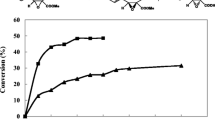Abstract
We have screened a new enzyme for the resolution ofR, S-naproxen enantiomers. The enzyme is free of lipase activity, and possesses a very high stereo-specificity on S-naproxen [2-(6-methoxy-2-naphthyl)-propionic acid] esters and esters of related drugs. The primary structure of the enzyme, determined from the nucleotide sequence, shows limited homology with the catalytic site of lipases. The gene coding for the stereo-selective carboxylesterase has been cloned and expressed inBacillus subtilis. Using a multicopy vector and an additional strong promoter an efficient production process was developed.
The enzyme was shown to be sensitive to very high concentrations of the products formed during the reaction it catalyses. To increase the resistance of the enzyme, lysine residues thought to be responsible for this phenomenon were replaced through site-directed mutagenesis. Enzymes with improved stability were obtained. An explanation is given in terms of a model in which a reaction of the acid moiety of naproxen with free lysine NH2 groups is a major cause of inactivation.
Similar content being viewed by others
References
Chan HW, Salazar FH (1991) Cloning, expression and sequencing of an ester hydrolase gene inEscherichia coli. European patent no. EP0414247.
Estell DA, Graycar TP, Wells JA (1985) Engineering an enzyme by site-directed mutagenesis to be resistant to chemical oxidation. J Biol Chem 260:6518–6521
Gruss A, Ehrlich SD (1989) The family of highly interrelated single-stranded deoxyribonucleic acid plasmids. Microbiol Rev 53:231–241
Gu Q-M, Chen CS, Sih CJ (1986) A facile enzymatic resolution process for the preparation of (+)-S-2-(6-methoxy-2-naphthyl) propionic acid (naproxen) Tetrahedron Lett 27:1763
Higerd TB, Riefler JF III (1976) Intracellular esterases ofBacillus subtilis. In: D. Schlessinger (ed) Microbiology 1976. American Society for Microbiology, Washington, D. C., pp 202–206
Higerd T, Spizizen J (1973) Isolation of two acetyl esterases from extracts ofBacillus subtilis. J Bacteriol 114: 1184–1192
Iriuchijima S, Keiyu A (1981) Asymmetric hydrolysis of (+-) α-substituted carboxylic acid esters with micro-organisms. Agric Biol Chem: 45, 1389
Kugimiya W, Otani Y, Hashimoto Y (1992) Molecular cloning and structure of the gene for esterase from a thermophilic bacterium,Bacillus stearothermophilus IFO 12550. Biosci Biotech Biochem 56: 2074–2075
Laan J-M van der, Teplyakov AV, Lammers AA, Dijkstra BW (1993) Preliminary X-ray study of naproxen esterase fromBacillus subtilis. J Mol Biol 230: 681–683
Meghji K, Ward OP, Araujo A (1990) Production, purification, and properties of extracellular carboxyl esterases fromBacillus subtilis NRRL 365. Appl Environ Microbiol 56: 3735–3740
Mustranta A (1992) Use of lipase in the resolution of racemic ibuprofen. Appl Microbiol Biotechnol 38: 61–66
Mutsaers JHGM, Kooreman HJ (1991) Preparation of optically pure 2-aryl- and 2-aryloxy-propionates by selective enzymatic hydrolysis. Recl Trav Chim Pays-Bas 110: 185
Nilsson B, Uhlen M, Josephson S, Gathenbak S, Philipson L (1983) Improved positive selection vector constructed by oligonucleotide mediated mutagenesis Nucleic Acids Res 11: 8019
Quax WJ, Mrabet NT, Luiten RGM, Schuurhuizen PW, Stanssens P, Lasters I (1991) Enhancing the thermostability of glucose isomerase by protein engineering. Bio/Technology 9: 738–742
Roszkowski AP, Rooks WH, Tomolonis AJ, Miller LM (1971) Antiinflammatory and analgesis properties of d-2-(6'-methoxy-2'-naphtyl)-propionic acid (naproxen). J Pharmacol Exp. Ther 179: 114
Schmid RD (1979) Chemically modified soluble enzymes. Adv Biochem Eng 12: 68–115
Smeets JWH, Kieboom APG (1992) Enzymatic enantioselective ester hydrolysis by carboxylesterase NP. Recl Trav Chim Pays-Bas 111: 490
Stanssens P, Opsomer C, McKeown YM, Kramer W, Zabeau M, Fritz H-J (1989) Efficient oligonucleotide directed construction of mutations in expression vectors by the gapped duplex DNA method using alternating selectable markers. Nucleic Acids Res 17: 4441–4454
Zyprian E, Matzura H (1986) Characterization of signals promoting gene expression on theStaphylococcus aureus plasmid pUB110 and development of a Gram-positive expression vector system. DNA 5: 219
Author information
Authors and Affiliations
Rights and permissions
About this article
Cite this article
Quax, W.J., Broekhuizen, C.P. Development of a newBacillus carboxyl esterase for use in the resolution of chiral drugs. Appl Microbiol Biotechnol 41, 425–431 (1994). https://doi.org/10.1007/BF00939031
Received:
Accepted:
Issue Date:
DOI: https://doi.org/10.1007/BF00939031




